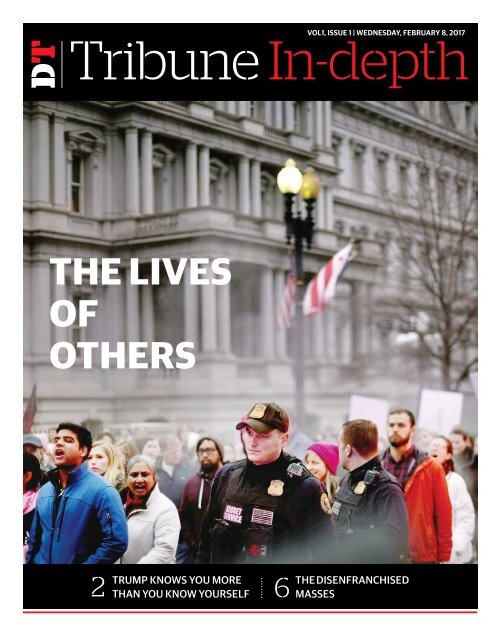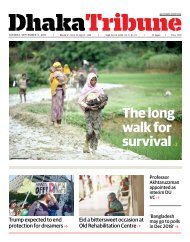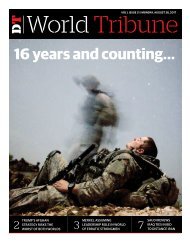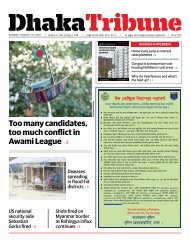You also want an ePaper? Increase the reach of your titles
YUMPU automatically turns print PDFs into web optimized ePapers that Google loves.
DT<br />
VOL1, ISSUE 1 | wednesday, february 8, <strong>2017</strong><br />
Tribune <strong>In</strong>-depth<br />
The lives<br />
of<br />
others<br />
2<br />
Trump knows you more<br />
than you know yourself<br />
The disenfranchised<br />
6 masses
2<br />
wednesday, february 8, <strong>2017</strong><br />
DT<br />
<strong>In</strong>-depth<br />
Trump knows you more than you know yourself<br />
The data that turned the world upside down<br />
• Hannes Grassegger and<br />
Mikael Krogerus<br />
Psychologist Michal<br />
Kosinski developed<br />
a method to analyse<br />
people in minute detail<br />
based on their Facebook<br />
activity. Did a similar tool help<br />
propel Donald Trump to victory?<br />
Two reporters from Zurich-based<br />
Das Magazin (where an earlier<br />
version of this story appeared in<br />
December in German) went datagathering.<br />
On November 9, at around<br />
8:30am, Michal Kosinski woke up<br />
in the Hotel Sunnehus in Zurich.<br />
The 34-year-old researcher had<br />
come to give a lecture at the Swiss<br />
Federal <strong>In</strong>stitute of Technology<br />
(ETH) about the dangers of Big<br />
Data and the digital revolution.<br />
Kosinski gives regular lectures on<br />
this topic all over the world. He is<br />
a leading expert in psychometrics,<br />
a data-driven sub-branch of<br />
psychology. When he turned on<br />
the TV that morning, he saw that<br />
the bombshell had exploded:<br />
Contrary to forecasts by all leading<br />
statisticians, Donald J Trump<br />
had been elected president of the<br />
United States.<br />
For a long time, Kosinski<br />
watched the Trump victory<br />
celebrations and the results coming<br />
in from each state. He had a hunch<br />
that the outcome of the election<br />
might have something to do with<br />
his research. Finally, he took a deep<br />
breath and turned off the TV.<br />
On the same day, a then<br />
little-known British company<br />
based in London sent out a press<br />
release: “We are thrilled that our<br />
revolutionary approach to datadriven<br />
communication has played<br />
such an integral part in Presidentelect<br />
Trump’s extraordinary win,”<br />
Alexander James Ashburner<br />
Nix was quoted as saying. Nix is<br />
British, 41 years old, and CEO of<br />
Cambridge Analytica. He is always<br />
immaculately turned out in tailormade<br />
suits and designer glasses,<br />
with his wavy blonde hair combed<br />
back from his forehead. His<br />
company wasn’t just integral to<br />
Trump’s online campaign, but to<br />
the UK’s Brexit campaign as well.<br />
Of these three players --<br />
reflective Kosinski, carefully<br />
groomed Nix, and grinning Trump<br />
-- one of them enabled the digital<br />
revolution, one of them executed<br />
it, and one of them benefited from<br />
it.<br />
How dangerous is Big Data?<br />
Anyone who has not spent the last<br />
five years living on another planet<br />
will be familiar with the term Big<br />
Data. Big Data means, in essence,<br />
Big Data is coming for you<br />
Kosinski continued to work on the models incessantly. Before<br />
long, he was able to evaluate a person better than the average<br />
work colleague, merely on the basis of 10 Facebook ‘likes.’<br />
that everything we do, both on<br />
and offline, leaves digital traces.<br />
Every purchase we make with<br />
our cards, every search we type<br />
into Google, every movement we<br />
make when our mobile phone is in<br />
our pocket, every “like” is stored.<br />
Especially every “like.”<br />
For a long time, it was not<br />
entirely clear what use this data<br />
could have -- except, perhaps, that<br />
we might find ads for high blood<br />
pressure remedies just after we’ve<br />
Googled “reduce blood pressure.”<br />
On November 9, it became clear<br />
that maybe much more is possible.<br />
The company behind Trump’s<br />
online campaign -- the same<br />
company that had worked for<br />
Leave.EU in the very early stages<br />
of its “Brexit” campaign -- was<br />
a Big Data company: Cambridge<br />
Analytica.<br />
To understand the outcome of<br />
the election -- and how political<br />
communication might work in the<br />
future -- we need to begin with<br />
a strange incident at Cambridge<br />
University in 2014, at Kosinski’s<br />
Psychometrics Centre.<br />
Psychometrics, sometimes also<br />
called psychographics, focuses<br />
on measuring psychological<br />
traits, such as personality. <strong>In</strong> the<br />
1980s, two teams of psychologists<br />
developed a model that sought to<br />
assess human beings based on five<br />
personality traits, known as the<br />
“Big Five.” These are: Openness<br />
(how open you are to new<br />
experiences?), conscientiousness<br />
(how much of a perfectionist are<br />
you?), extroversion (how sociable<br />
are you?), agreeableness (how<br />
considerate and cooperative are<br />
you?) and neuroticism (are you<br />
easily upset?).<br />
Based on these dimensions<br />
-- they are also known as OCEAN,<br />
an acronym for openness,<br />
conscientiousness, extroversion,<br />
agreeableness, neuroticism -- we<br />
can make a relatively accurate<br />
assessment of the kind of person<br />
in front of us. This includes their<br />
needs and fears, and how they are<br />
likely to behave.<br />
The “Big Five” has become<br />
the standard technique of<br />
psychometrics. But for a long time,<br />
the problem with this approach<br />
was data collection, because it<br />
involved filling out a complicated,<br />
highly personal questionnaire.<br />
Then came the internet. And<br />
Facebook. And Kosinski.<br />
Michal Kosinski was a student<br />
in Warsaw when his life took a new<br />
direction in 20<strong>08</strong>. He was accepted<br />
by Cambridge University to do his<br />
PhD at the Psychometrics Centre,<br />
one of the oldest institutions of<br />
this kind worldwide.<br />
Kosinski joined fellow student<br />
David Stillwell (now a lecturer<br />
at Judge Business School at the<br />
University of Cambridge) about a<br />
year after Stillwell had launched<br />
a little Facebook application in<br />
the days when the platform had<br />
not yet become the behemoth it<br />
is today. Their MyPersonality app<br />
enabled users to fill out different<br />
psychometric questionnaires,<br />
including a handful of options<br />
from the Big Five personality<br />
questionnaire (“I panic easily,”<br />
“I contradict others”). Based on<br />
the evaluation, users received a<br />
“personality profile” -- individual<br />
Big Five values -- and could opt-in<br />
to share their Facebook profile<br />
data with the researchers.<br />
Kosinski had expected a few<br />
dozen college friends to fill in<br />
the questionnaire, but before<br />
Bigstock<br />
long, hundreds, thousands, then<br />
millions of people had revealed<br />
their innermost convictions.<br />
Suddenly, the two doctoral<br />
candidates owned the largest<br />
dataset combining psychometric<br />
scores with Facebook profiles ever<br />
to be collected.<br />
The approach that Kosinski and<br />
his colleagues developed over the<br />
next few years was actually quite<br />
simple. First, they provided test<br />
subjects with a questionnaire in<br />
the form of an online quiz. From<br />
their responses, the psychologists<br />
calculated the personal Big Five<br />
values of respondents. Kosinski’s<br />
team then compared the results<br />
with all sorts of other online data<br />
from the subjects: What they<br />
“liked,” shared, or posted on<br />
Facebook, or what gender, age,<br />
place of residence they specified,<br />
for example. This enabled the<br />
researchers to connect the dots<br />
and make correlations.<br />
Remarkably reliable deductions<br />
could be drawn from simple<br />
online actions. For example,<br />
men who “liked” the cosmetics<br />
brand MAC were slightly more<br />
likely to be gay; one of the best<br />
indicators for heterosexuality<br />
was “liking” Wu-Tang Clan.<br />
Followers of Lady Gaga were<br />
most probably extroverts, while<br />
those who “liked” philosophy<br />
tended to be introverts. While<br />
each piece of such information<br />
is too weak to produce a reliable<br />
prediction, when tens, hundreds,<br />
or thousands of individual data<br />
points are combined, the resulting<br />
predictions become really<br />
accurate.<br />
Kosinski and his team tirelessly<br />
refined their models.<br />
<strong>In</strong> 2012, Kosinski proved that
<strong>In</strong>-depth<br />
3<br />
wednesday, february 8, <strong>2017</strong><br />
DT<br />
The more radical of the two Brexit campaigns, ‘Leave.EU,’<br />
announced that it had commissioned a Big Data company to<br />
support its online campaign: Cambridge Analytica. The company’s<br />
core strength: <strong>In</strong>novative political marketing -- micro-targeting -- by<br />
measuring people’s personality from their digital footprints<br />
on the basis of an average of 68<br />
Facebook “likes” by a user, it was<br />
possible to predict their skin color<br />
(with 95% accuracy), their sexual<br />
orientation (88% accuracy), and<br />
their affiliation to the Democratic<br />
or Republican party (85%).<br />
But it didn’t stop there.<br />
<strong>In</strong>telligence, religious affiliation,<br />
as well as alcohol, cigarette, and<br />
drug use, could all be determined.<br />
From the data it was even possible<br />
to deduce whether someone’s<br />
parents were divorced.<br />
The strength of their modeling<br />
was illustrated by how well it<br />
could predict a subject’s answers.<br />
Kosinski continued to work on<br />
the models incessantly. Before<br />
long, he was able to evaluate a<br />
person better than the average<br />
work colleague, merely on the<br />
basis of 10 Facebook “likes.” 70<br />
“likes” were enough to outdo<br />
what a person’s friends knew, 150<br />
what their parents knew, and 300<br />
“likes” what their partner knew.<br />
More “likes” could even surpass<br />
what a person thought they knew<br />
about themselves. On the day that<br />
Kosinski published these findings,<br />
he received two phone calls. The<br />
threat of a lawsuit and a job offer.<br />
Both from Facebook.<br />
Only weeks later Facebook<br />
“likes” became private by default.<br />
Before that, the default setting was<br />
that anyone on the internet could<br />
see your “likes.” But this was no<br />
obstacle to data collectors: While<br />
Kosinski always asked for the<br />
consent of Facebook users, many<br />
apps and online quizzes today<br />
require access to private data as a<br />
precondition for taking personality<br />
tests. (Anybody who wants to<br />
evaluate themselves based on<br />
their Facebook “likes” can do<br />
so on Kosinski’s website, and then<br />
compare their results to those of<br />
a classic OCEAN questionnaire,<br />
like that of the Cambridge<br />
Psychometrics Centre.)<br />
But it was not just about “likes”<br />
or even Facebook: Kosinski and his<br />
team could now ascribe Big Five<br />
values based purely on how many<br />
profile pictures a person has on<br />
Facebook, or how many contacts<br />
they have (a good indicator of<br />
extroversion). But we also reveal<br />
something about ourselves<br />
even when we’re not online. For<br />
example, the motion sensor on<br />
our phone reveals how quickly<br />
we move and how far we travel<br />
(this correlates with emotional<br />
instability). Our smartphone,<br />
Kosinski concluded, is a vast<br />
psychological questionnaire that<br />
we are constantly filling out, both<br />
consciously and unconsciously.<br />
Above all, however -- and this is<br />
key -- it also works in reverse. Not<br />
only can psychological profiles be<br />
created from your data, but your<br />
data can also be used the other<br />
way round to search for specific<br />
profiles: All anxious fathers, all<br />
angry introverts, for example<br />
-- or maybe even all undecided<br />
Democrats?<br />
Essentially, what Kosinski had<br />
invented was sort of a people<br />
search engine. He started to<br />
recognise the potential -- but also<br />
the inherent danger -- of his work.<br />
To him, the internet had always<br />
seemed like a gift from heaven.<br />
What he really wanted was to give<br />
something back, to share. Data<br />
can be copied, so why shouldn’t<br />
everyone benefit from it? It was<br />
the spirit of a whole generation,<br />
the beginning of a new era that<br />
transcended the limitations of the<br />
physical world. But what would<br />
happen, wondered Kosinski, if<br />
someone abused his people search<br />
engine to manipulate people? He<br />
began to add warnings to most of<br />
his scientific work. His approach,<br />
he warned, “could pose a threat<br />
to an individual’s well-being,<br />
freedom, or even life.” But no one<br />
seemed to grasp what he meant.<br />
Around this time, in early 2014,<br />
Kosinski was approached by a<br />
young assistant professor in the<br />
psychology department called<br />
Aleksandr Kogan. He said he was<br />
inquiring on behalf of a company<br />
that was interested in Kosinski’s<br />
method, and wanted to access the<br />
MyPersonality database. Kogan<br />
wasn’t at liberty to reveal for what<br />
purpose; he was bound to secrecy.<br />
At first, Kosinski and his team<br />
considered this offer, as it would<br />
mean a great deal of money for the<br />
institute, but then he hesitated.<br />
Finally, Kosinski remembers,<br />
Kogan revealed the name of<br />
the company: SCL (Strategic<br />
Communication Laboratories).<br />
Kosinski Googled the company:<br />
“[We are] the premier election<br />
management agency,” says the<br />
company’s website. SCL provides<br />
marketing based on psychological<br />
modeling. One of its core focuses:<br />
<strong>In</strong>fluencing elections.<br />
<strong>In</strong>fluencing elections?<br />
Perturbed, Kosinski clicked<br />
through the pages. What kind of<br />
company was this? And what were<br />
these people planning?<br />
What Kosinski did not know<br />
at the time: SCL is the parent of a<br />
group of companies. Who exactly<br />
owns SCL and its diverse branches<br />
is unclear, thanks to a convoluted<br />
corporate structure, the type seen<br />
in the UK Companies House, the<br />
Panama Papers, and the Delaware<br />
company registry.<br />
Some of the SCL offshoots<br />
have been involved in<br />
elections from Ukraine to<br />
Nigeria, helped the Nepalese<br />
monarch against the rebels,<br />
whereas others have developed<br />
methods to influence Eastern<br />
European and Afghan citizens for<br />
NATO. And, in 2013, SCL spun off a<br />
new company to participate in US<br />
elections: Cambridge Analytica.<br />
Kosinski knew nothing about all<br />
this, but he had a bad feeling. “The<br />
whole thing started to stink,” he<br />
recalls. On further investigation,<br />
he discovered that Aleksandr<br />
Kogan had secretly registered a<br />
company doing business with<br />
SCL. According to a December<br />
2015 report in The Guardian and<br />
to internal company documents<br />
given to Das Magazin, it emerges<br />
that SCL learned about Kosinski’s<br />
method from Kogan.<br />
Kosinski came to suspect that<br />
Kogan’s company might have<br />
reproduced the Facebook likesbased<br />
Big Five measurement tool<br />
in order to sell it to this electioninfluencing<br />
firm. He immediately<br />
broke off contact with Kogan<br />
and informed the director of the<br />
institute, sparking a complicated<br />
conflict within the university.<br />
The institute was worried about<br />
its reputation. Aleksandr Kogan<br />
then moved to Singapore, married,<br />
and changed his name to Dr<br />
Spectre. Michal Kosinski finished<br />
his PhD, got a job offer from<br />
Stanford, and moved to the US.<br />
Mr Brexit<br />
All was quiet for about a year.<br />
Then, in November 2015, the<br />
more radical of the two Brexit<br />
campaigns, “Leave.EU,” supported<br />
by Nigel Farage, announced that<br />
it had commissioned a Big Data<br />
company to support its online<br />
campaign: Cambridge Analytica.<br />
The company’s core strength:<br />
<strong>In</strong>novative political marketing<br />
-- micro-targeting -- by measuring<br />
people’s personality from their<br />
digital footprints, based on the<br />
OCEAN model.<br />
Now Kosinski received emails<br />
asking what he had to do with it --<br />
the words Cambridge, personality,<br />
and analytics immediately made<br />
many people think of Kosinski.<br />
It was the first time he had heard<br />
of the company, which borrowed<br />
its name, it said, from its first<br />
employees, researchers from the<br />
university. Horrified, he looked at<br />
the website. Was his methodology<br />
being used on a grand scale for<br />
political purposes?<br />
After the Brexit result, friends<br />
and acquaintances wrote to him:<br />
Just look at what you’ve done.<br />
Everywhere he went, Kosinski had<br />
to explain that he had nothing to<br />
do with this company. It remains<br />
unclear how deeply Cambridge<br />
Analytica was involved in the<br />
Brexit campaign (Cambridge<br />
Analytica would not discuss such<br />
Political ideology wasn’t the only thing Trump and Brexit had in common<br />
questions).<br />
For a few months, things<br />
were relatively quiet. Then, on<br />
September 19, 2016, just over a<br />
month before the US elections,<br />
the guitar riffs of Creedence<br />
Clearwater Revival’s “Bad Moon<br />
Rising” fill the dark-blue hall of<br />
New York’s Grand Hyatt hotel.<br />
The Concordia Summit is a kind<br />
of World Economic Forum in<br />
miniature. Decision-makers<br />
from all over the world have<br />
been invited, among them Swiss<br />
President Johann Schneider-<br />
Ammann.<br />
“Please welcome to the stage<br />
Alexander Nix, chief executive<br />
officer of Cambridge Analytica,” a<br />
smooth female voice announces.<br />
A slim man in a dark suit walks<br />
onto the stage. A hush falls. Many<br />
in attendance know that this is<br />
Trump’s new digital strategy man<br />
(a video of the presentation was<br />
posted on YouTube.)<br />
A few weeks earlier, Trump had<br />
tweeted, somewhat cryptically:<br />
“Soon you’ll be calling me Mr<br />
Brexit.” Political observers had<br />
indeed noticed some striking<br />
similarities between Trump’s<br />
agenda and that of the rightwing<br />
Brexit movement. But<br />
few had noticed the connection<br />
with Trump’s recent hiring of<br />
a marketing company named<br />
Cambridge Analytica.<br />
Up to this point, Trump’s digital<br />
campaign had consisted of more<br />
or less one person: Brad Parscale, a<br />
marketing entrepreneur and failed<br />
start-up founder who created a<br />
rudimentary website for Trump<br />
for $1,500. The 70-year-old Trump<br />
is not digitally savvy -- there isn’t<br />
even a computer on his office<br />
desk. Trump doesn’t do emails, his<br />
personal assistant once revealed.<br />
She herself talked him into having<br />
a smartphone, from which he now<br />
tweets incessantly.<br />
Hillary Clinton, on the other<br />
hand, relied heavily on the<br />
legacy of the first “social-media<br />
president,” Barack Obama.<br />
She had the address lists of<br />
the Democratic Party, worked<br />
Bigstock
4<br />
wednesday, february 8, <strong>2017</strong><br />
DT<br />
<strong>In</strong>-depth<br />
with cutting-edge big data<br />
analysts from BlueLabs and<br />
received support from Google<br />
and DreamWorks. When it was<br />
announced in June 2016 that<br />
Trump had hired Cambridge<br />
Analytica, the establishment in<br />
Washington just turned up their<br />
noses. Foreign dudes in tailormade<br />
suits who don’t understand<br />
the country and its people?<br />
Seriously?<br />
“It is my privilege to speak to<br />
you today about the power of Big<br />
Data and psychographics in the<br />
electoral process.” The logo of<br />
Cambridge Analytica -- a brain<br />
composed of network nodes, like a<br />
map -- appears behind Alexander<br />
Nix. “Only 18 months ago, Senator<br />
Cruz was one of the less popular<br />
candidates,” explains the blonde<br />
man in a cut-glass British accent,<br />
which puts Americans on edge the<br />
same way that a standard German<br />
accent can unsettle Swiss people.<br />
“Less than 40% of the population<br />
had heard of him,” another slide<br />
says. Cambridge Analytica had<br />
become involved in the US election<br />
campaign almost two years<br />
earlier, initially as a consultant<br />
for Republicans Ben Carson and<br />
Ted Cruz. Cruz -- and later Trump<br />
-- was funded primarily by the<br />
secretive US software billionaire<br />
Robert Mercer who, along with<br />
his daughter Rebekah, is reported<br />
to be the largest investor in<br />
Cambridge Analytica.<br />
“So how did he do this?” Up<br />
to now, explains Nix, election<br />
campaigns have been organised<br />
based on demographic concepts.<br />
“A really ridiculous idea. The idea<br />
that all women should receive<br />
the same message because of<br />
their gender -- or all African<br />
Americans because of their<br />
Nix finishes his<br />
lecture at the<br />
Concordia Summit<br />
by stating that<br />
traditional blanket<br />
advertising is<br />
dead. And before<br />
leaving the stage,<br />
he announced<br />
that since Cruz<br />
had left the race,<br />
the company<br />
was helping one<br />
of the remaining<br />
presidential<br />
candidates<br />
race.” What Nix meant is that<br />
while other campaigners so far<br />
have relied on demographics,<br />
Cambridge Analytica was using<br />
psychometrics.<br />
Though this might be true,<br />
Cambridge Analytica’s role within<br />
Cruz’s campaign isn’t undisputed.<br />
<strong>In</strong> December 2015, the Cruz team<br />
credited their rising success to<br />
psychological use of data and<br />
analytics. <strong>In</strong> Advertising Age, a<br />
political client said the embedded<br />
Cambridge staff was “like an<br />
extra wheel,” but found their<br />
core product, Cambridge’s voter<br />
data modeling, still “excellent.”<br />
The campaign would pay the<br />
company at least $5.8 million<br />
to help identify voters in the Iowa<br />
caucuses, which Cruz won, before<br />
dropping out of the race in May.<br />
Nix clicks to the next slide:<br />
Five different faces, each face<br />
corresponding to a personality<br />
profile. It is the Big Five or OCEAN<br />
Model. “At Cambridge,” he said,<br />
“we were able to form a model to<br />
predict the personality of every<br />
single adult in the United States of<br />
America.” The hall is captivated.<br />
According to Nix, the success of<br />
Cambridge Analytica’s marketing<br />
is based on a combination of three<br />
elements: Behavioural science<br />
using the OCEAN Model, Big<br />
Data analysis, and ad targeting.<br />
Ad targeting is personalised<br />
advertising, aligned as accurately<br />
as possible to the personality of an<br />
individual consumer.<br />
Nix candidly explains how<br />
his company does this. First,<br />
Cambridge Analytica buys<br />
personal data from a range<br />
of different sources, like land<br />
registries, automotive data,<br />
shopping data, bonus cards, club<br />
memberships, what magazines<br />
Is data mining the way to win elections?<br />
you read, what churches you<br />
attend. Nix displays the logos of<br />
globally active data brokers like<br />
Acxiom and Experian -- in the US,<br />
almost all personal data is for sale.<br />
For example, if you want to<br />
know where Jewish women<br />
live, you can simply buy this<br />
information, phone numbers<br />
included. Now Cambridge<br />
Analytica aggregates this data<br />
with the electoral rolls of the<br />
Republican party and online<br />
data and calculates a Big Five<br />
personality profile. Digital<br />
footprints suddenly become real<br />
people with fears, needs, interests,<br />
and residential addresses.<br />
The methodology looks<br />
quite similar to the one that<br />
Michal Kosinski once developed.<br />
Cambridge Analytica also uses,<br />
Nix told us, “surveys on social<br />
media” and Facebook data. And<br />
the company does exactly what<br />
Kosinski warned of: “We have<br />
profiled the personality of every<br />
adult in the United States of<br />
America -- 220 million people,” Nix<br />
boasts.<br />
He opens the screenshot.<br />
“This is a data dashboard that we<br />
prepared for the Cruz campaign.” A<br />
digital control centre appears. On<br />
the left are diagrams; on the right,<br />
a map of Iowa, where Cruz won a<br />
surprisingly large number of votes<br />
in the primary. And on the map,<br />
there are hundreds of thousands<br />
of small red and blue dots. Nix<br />
narrows down the criteria:<br />
“Republicans” -- the blue dots<br />
disappear; “not yet convinced”<br />
-- more dots disappear; “male,”<br />
and so on. Finally, only one name<br />
remains, including age, address,<br />
interests, personality, and political<br />
inclination.<br />
How does Cambridge Analytica<br />
now target this person with an<br />
appropriate political message?<br />
Nix shows how psychographically<br />
categorised voters can be<br />
differently addressed, based<br />
on the example of gun rights,<br />
the Second Amendment: “For a<br />
highly neurotic and conscientious<br />
audience, the threat of a burglary<br />
-- and the insurance policy of a<br />
gun.” An image on the left shows<br />
the hand of an intruder smashing<br />
a window. The right side shows<br />
a man and a child standing in<br />
a field at sunset, both holding<br />
guns, clearly shooting ducks:<br />
“Conversely, for a closed and<br />
agreeable audience. People who<br />
care about tradition, and habits,<br />
and family.”<br />
How to keep Clinton voters away<br />
from the ballot box<br />
Trump’s striking inconsistencies,<br />
his much-criticised fickleness, and<br />
the resulting array of contradictory<br />
messages, suddenly turned out<br />
to be his great asset: A different<br />
message for every voter. The<br />
notion that Trump acted like a<br />
perfectly opportunistic algorithm<br />
following audience reactions is<br />
something the mathematician<br />
Cathy O’Neil observed in August<br />
2016.<br />
“Pretty much every message<br />
that Trump put out was<br />
data-driven,” Alexander Nix<br />
remembers. On the day of the<br />
third presidential debate between<br />
Trump and Clinton, Trump’s<br />
team tested 175,000 different ad<br />
variations for his arguments, in<br />
order to find the right versions<br />
above all via Facebook. The<br />
messages differed for the most<br />
part only in microscopic details,<br />
in order to target the recipients<br />
in the optimal psychological<br />
Bigstock<br />
way: Different headings, colours,<br />
captions, with a photo or video.<br />
This fine-tuning reaches all the<br />
way down to the smallest groups,<br />
Nix explained in an interview<br />
with us. “We can address villages<br />
or apartment blocks in a targeted<br />
way. Even individuals.”<br />
<strong>In</strong> the Miami district of Little<br />
Haiti, for instance, Trump’s<br />
campaign provided inhabitants<br />
with news about the failure of the<br />
Clinton Foundation following the<br />
earthquake in Haiti, in order to<br />
keep them from voting for Hillary<br />
Clinton. This was one of the<br />
goals: To keep potential Clinton<br />
voters (which include wavering<br />
left-wingers, African-Americans,<br />
and young women) away from<br />
the ballot box, to “suppress” their<br />
vote, as one senior campaign<br />
official told Bloomberg in the<br />
weeks before the election.<br />
These “dark posts” -- sponsored<br />
news-feed-style ads on Facebook<br />
timelines that can only be seen<br />
by users with specific profiles --<br />
included videos aimed at African-<br />
Americans in which Hillary Clinton<br />
refers to black men as predators,<br />
for example.<br />
Nix finishes his lecture at the<br />
Concordia Summit by stating that<br />
traditional blanket advertising is<br />
dead. “My children will certainly<br />
never, ever understand this<br />
concept of mass communication.”<br />
And before leaving the stage, he<br />
announced that since Cruz had left<br />
the race, the company was helping<br />
one of the remaining presidential<br />
candidates.<br />
Just how precisely the<br />
American population was being<br />
targeted by Trump’s digital troops<br />
at that moment was not visible,<br />
because they attacked less on<br />
mainstream TV and more with<br />
personalised messages on social<br />
media or digital TV. And while the<br />
Clinton team thought it was in<br />
the lead, based on demographic<br />
projections, Bloomberg journalist<br />
Sasha Issenberg was surprised<br />
to note on a visit to San Antonio<br />
-- where Trump’s digital campaign<br />
was based -- that a “second<br />
headquarters” was being created.<br />
The embedded Cambridge<br />
Analytica team, apparently only a<br />
dozen people, received $100,000<br />
from Trump in July, $250,000<br />
in August, and $5 million in<br />
September. According to Nix,<br />
the company earned over $15<br />
million overall. The company is<br />
incorporated in the US, where laws<br />
regarding the release of personal<br />
data are more lax than in European<br />
Union countries (whereas European<br />
privacy laws require a person to<br />
“opt in” to a release of data, those<br />
in the US permit data to be released<br />
unless a user “opts out”).<br />
The measures were radical:<br />
From July 2016, Trump’s<br />
canvassers were provided with an<br />
app with which they could identify<br />
the political views and personality<br />
types of the inhabitants of a house.<br />
It was the same app provider used
<strong>In</strong>-depth 5<br />
DT<br />
wednesday, february 8, <strong>2017</strong><br />
Now the businessman-in-chief has the world in his hands<br />
REUTERS<br />
by Brexit campaigners. Trump’s<br />
people only rang at the doors<br />
of houses that the app rated as<br />
receptive to his messages. The<br />
canvassers came prepared with<br />
guidelines for conversations<br />
tailored to the personality type<br />
of the resident. <strong>In</strong> turn, the<br />
canvassers fed the reactions into<br />
the app, and the new data flowed<br />
back to the dashboards of the<br />
Trump campaign.<br />
Again, this is nothing new. The<br />
Democrats did similar things, but<br />
there is no evidence that they<br />
relied on psychometric profiling.<br />
Cambridge Analytica, however,<br />
divided the US population into 32<br />
personality types, and focused on<br />
just 17 states. And just as Kosinski<br />
had established that men who<br />
like MAC cosmetics are slightly<br />
more likely to be gay, the company<br />
discovered that a preference for<br />
cars made in the US was a great<br />
indication of a potential Trump<br />
voter. Among other things, these<br />
findings now showed Trump<br />
which messages worked best and<br />
where.<br />
The decision to focus on<br />
Michigan and Wisconsin in the<br />
final weeks of the campaign was<br />
made on the basis of data analysis.<br />
The candidate became the<br />
instrument for implementing a big<br />
data model.<br />
What’s next?<br />
But to what extent did<br />
psychometric methods influence<br />
the outcome of the election? When<br />
asked, Cambridge Analytica was<br />
unwilling to provide any proof of<br />
It is an irony of history that Trump, who often grumbled about<br />
scientific research, used a highly scientific approach in his<br />
campaign<br />
the effectiveness of its campaign.<br />
And it is quite possible that the<br />
question is impossible to answer.<br />
And yet there are clues: There is<br />
the fact of the surprising rise of Ted<br />
Cruz during the primaries. Also,<br />
there was an increased number of<br />
voters in rural areas. There was the<br />
decline in the number of African-<br />
American early votes. The fact<br />
that Trump spent so little money<br />
may also be explained by the<br />
effectiveness of personality-based<br />
advertising.<br />
As does the fact that he<br />
invested far more in digital than<br />
TV campaigning compared to<br />
Hillary Clinton. Facebook proved<br />
to be the ultimate weapon and the<br />
best election campaigner, as Nix<br />
explained, and as comments by<br />
several core Trump campaigners<br />
demonstrate.<br />
Many voices have claimed<br />
that the statisticians lost the<br />
election because their predictions<br />
were so off the mark. But what<br />
if statisticians in fact helped win<br />
the election -- but only those who<br />
were using the new method?<br />
It is an irony of history that<br />
Trump, who often grumbled<br />
about scientific research, used a<br />
highly scientific approach in his<br />
campaign.<br />
Another big winner is<br />
Cambridge Analytica. Its board<br />
member Steve Bannon, former<br />
executive chair of the right-wing<br />
online newspaper Breitbart News,<br />
has been appointed as Donald<br />
Trump’s senior counselor and<br />
chief strategist.<br />
Whilst Cambridge Analytica is<br />
not willing to comment on alleged<br />
ongoing talks with UK Prime<br />
Minister Theresa May, Alexander<br />
Nix claims that he is building up<br />
his client base worldwide, and<br />
that he has received inquiries<br />
from Switzerland, Germany, and<br />
Australia. His company is currently<br />
touring European conferences<br />
showcasing their success in the<br />
US. This year three core countries<br />
of the EU are facing elections<br />
with resurgent populist parties:<br />
France, Holland, and Germany.<br />
The electoral successes come at an<br />
opportune time, as the company<br />
is readying for a push into<br />
commercial advertising.<br />
Kosinski has observed all of<br />
this from his office at Stanford.<br />
Following the US election, the<br />
university is in turmoil. Kosinski is<br />
responding to developments with<br />
the sharpest weapon available to a<br />
researcher: A scientific analysis.<br />
Together with his research<br />
colleague Sandra Matz, he has<br />
conducted a series of tests, which<br />
will soon be published. The<br />
initial results are alarming: The<br />
study shows the effectiveness of<br />
personality targeting by showing<br />
that marketers can attract up<br />
to 63% more clicks and up to<br />
1,400 more conversions in<br />
real-life advertising campaigns<br />
on Facebook when matching<br />
products and marketing messages<br />
to consumers’ personality<br />
characteristics.<br />
They further demonstrate the<br />
scalability of personality targeting<br />
by showing that the majority<br />
of Facebook pages promoting<br />
products or brands are affected by<br />
personality and that large numbers<br />
of consumers can be accurately<br />
targeted based on a single<br />
Facebook page.<br />
<strong>In</strong> a statement after the<br />
German publication of this<br />
article, a Cambridge Analytica<br />
spokesperson said, “Cambridge<br />
Analytica does not use data from<br />
Facebook. It has had no dealings<br />
with Dr Michal Kosinski. It does<br />
not subcontract research. It does<br />
not use the same methodology.<br />
Psychographics was hardly used<br />
at all. Cambridge Analytica did<br />
not engage in efforts to discourage<br />
any Americans from casting their<br />
vote in the presidential election.<br />
Its efforts were solely directed<br />
towards increasing the number of<br />
voters in the election.”<br />
The world has been turned<br />
upside down. Great Britain is<br />
leaving the EU, Donald Trump<br />
is president of the US. And in<br />
Stanford, Kosinski, who wanted<br />
to warn against the danger of<br />
using psychological targeting in<br />
a political setting, is once again<br />
receiving accusatory emails. “No,”<br />
says Kosinski, quietly and shaking<br />
his head. “This is not my fault.<br />
I did not build the bomb. I only<br />
showed that it exists.” •<br />
Hannes Grassegger is a Swiss <strong>In</strong>ternet<br />
theorist and author of the economic<br />
manifest Das Kapital bin Ich and Mikael<br />
Krogerus is author of The Decision Book<br />
and editor of Das Magazine. This article<br />
was translated from German to English<br />
by Ed Sutton, a writer in aNtiDote Zine.
6<br />
wednesday, february 8, <strong>2017</strong><br />
DT<br />
<strong>In</strong>-depth<br />
The disenfranchised masses<br />
Do citizens in democracies have a voice, or just a vote?<br />
• Ashikur Rahman<br />
<strong>In</strong> recent times, the political<br />
world looks like a very<br />
strange place. Not only<br />
outcomes that are difficult<br />
to rationalise are occurring<br />
at an increasing frequency -- from<br />
Brexit to the electoral victory of<br />
Trump -- but there is a strange<br />
sense of frustration and anxiety<br />
that has gripped the political space<br />
across countries.<br />
A common underlying tone<br />
of this frustration is that most<br />
concerned citizens sense there is<br />
an acute disconnect between their<br />
individual or collective aspirations<br />
and how politics ultimately plays<br />
out. <strong>In</strong> essence, there is a sense<br />
of no real influence of citizens on<br />
laws that are passed in either the<br />
US Congress or <strong>In</strong>dian Lok Sabha,<br />
or the decisions that are taken in<br />
10 Downing Street.<br />
To better phrase the anxiety, it<br />
seems like in most democracies,<br />
citizens just have a mere vote<br />
every four or five years, but not a<br />
real voice to change or influence<br />
outcomes.<br />
This concern, that there<br />
might be a systematic<br />
disenfranchisement of masses<br />
from influencing outcomes<br />
that shape the quality of their<br />
respective lives within polities<br />
that are often categorised as an<br />
oasis of democracy, first captured<br />
my attention when I examined<br />
the comparative development<br />
analysis of <strong>In</strong>dia by Jeane Dreze<br />
and Amartya Sen in their book<br />
An Uncertain Glory. <strong>In</strong>terestingly,<br />
their examination revealed that<br />
in spite of benefitting from six<br />
decades of electoral politics,<br />
relatively free media, and strong<br />
Does democracy truly prioritise the interest of many over the few?<br />
judicial institutions which hold<br />
political elites accountable, across<br />
a large array of development<br />
indicators <strong>In</strong>dia has lagged<br />
substantially behind countries<br />
like Bangladesh or China --<br />
where democracy was either in<br />
its embryonic form or absent<br />
altogether (see Table 1).<br />
Of course, one might play<br />
devil’s advocate and argue that<br />
the only reason there is significant<br />
variation in development<br />
indicators between <strong>In</strong>dia,<br />
Bangladesh, and China is because<br />
voters or citizens in <strong>In</strong>dia have<br />
different policy preferences. Yet,<br />
this will be an overstretch as<br />
it is difficult to rationalise that<br />
poor parents in <strong>In</strong>dia care less<br />
about their children’s schooling<br />
or immunisation than parents in<br />
Bangladesh or China.<br />
Further, the fact that after<br />
six decades of electoral politics,<br />
nearly two-thirds of <strong>In</strong>dia does not<br />
have access to improved sanitation<br />
makes one contemplate if the<br />
ordinary voters have an actual<br />
power to influence resources that<br />
are diverted to them.<br />
The presence of such acute<br />
deprivation also can make one<br />
question: Why did voters in<br />
<strong>In</strong>dia fail to punish politicians<br />
for not adequately addressing<br />
bIGSTOCK<br />
such basic deprivations? Can’t<br />
a majoritarian political system<br />
ensure (at least) that such visible<br />
mass deprivation receive critical<br />
public scrutiny and are dealt with<br />
effective policies that worked in a<br />
relatively resource-poor country<br />
like Bangladesh?<br />
What stopped the vibrant <strong>In</strong>dia<br />
media from creating a hue cry over<br />
such issues? Do voters in <strong>In</strong>dia (or<br />
in other democracies) have any<br />
real influence on policies and laws<br />
that are ultimately agreed upon by<br />
the political elites?<br />
The questions posed above<br />
are critical for us to scrutinise<br />
so that we understand why<br />
and how majoritarian political<br />
systems, where electoral politics<br />
decide which exact set of parties<br />
or individuals govern, can<br />
nonetheless facilitate subtle mass<br />
disenfranchisement by allowing<br />
citizens to have votes, but no<br />
real voice or influence in shaping<br />
policies.<br />
Yet, this phenomenon is not<br />
solely an <strong>In</strong>dian problem. If we<br />
actually evaluate the state of<br />
many western liberal democracies,<br />
certain outcomes fail to make any<br />
rational sense if one agrees on the<br />
basic premise that democracies<br />
should be better able to prioritise<br />
the interest of the many over the
<strong>In</strong>-depth<br />
7<br />
wednesday, february 8, <strong>2017</strong><br />
DT<br />
interest of the few.<br />
Figure 1 illustrates a stark<br />
example of what is meant. As<br />
pointed out by the time series<br />
evolution of wealth inequality<br />
owned by the top 0.1% (yes, not 1%<br />
but top 0.1%) and the bottom 90%,<br />
it is evident that in contemporary<br />
times, both groups cumulatively<br />
have a similar level of wealth in<br />
the US. Most interestingly, the<br />
relative share of the wealth of top<br />
0.1% has witnessed a substantial<br />
rise after the late 1970s, and the<br />
relative wealth of the bottom 90%<br />
in US witnessed a gradual decline<br />
after the mid-1980s.<br />
Of course, this economic<br />
evolution can make one question<br />
that within a political avenue that<br />
witnessed the birth of the first<br />
constitutional democracy, how<br />
could citizens not find a scope to<br />
ensure politicians address such<br />
harsh degree of inequality through<br />
redistributive policies? Or should<br />
we accept the proposition that<br />
voters in the US do not care about<br />
economic inequality?<br />
Again, this is a difficult<br />
proposition to establish because,<br />
recent estimates not only suggest<br />
that more than 40 million people<br />
in the US live below the poverty<br />
line (which makes it difficult<br />
to believe that they are not<br />
concerned with the growing level<br />
of wealth inequality), recent<br />
opinion polls derived by PEW<br />
Research Center’s Global Attitudes<br />
Project have also indicated that<br />
“concerns of inequality trump all<br />
other danger” for respondents in<br />
United States and Europe.<br />
Thus, the case of US (just like<br />
<strong>In</strong>dia) only makes it legitimate<br />
for one to question if citizens,<br />
whose aspiration to defeat the<br />
harsh realities of their lives,<br />
actually suffer from subtle<br />
disenfranchisement where the<br />
political establishment allows<br />
them to vote, but their real voice<br />
and concerns have very little<br />
impact on the policies that are<br />
ultimately chosen.<br />
No wonder, one might even<br />
Why is it that in Canada, nearly three<br />
out of five people feel that their country<br />
is headed in the right direction, while<br />
in the US, only two in five will agree to<br />
that statement?<br />
argue that this sorry state of<br />
socio-economic reality in the US<br />
probably explains the acute deficit<br />
of trust of US citizens in its own<br />
government, which peaked with<br />
President Lyndon Johnson in 1964<br />
(who declared a war on poverty)<br />
and has witnessed a substantial<br />
decline ever since -- and recently<br />
stood at 19% (Figure-2). More<br />
importantly, can polities with<br />
this level of citizen distrust for<br />
their state apparatus have really<br />
extended the franchise to the<br />
ordinary masses?<br />
If we also examine the growth<br />
of inequality in other democracies<br />
(Figure-3), which coexists with<br />
the growing number of people<br />
Selected Development <strong>In</strong>dicator (2011)<br />
<strong>In</strong>dicators <strong>In</strong>dia Bangladesh China<br />
GDP per Capita (PPP, 2005 Constant international $) 3203 1569 7418<br />
Life Expectancy at Birth (years) 65 69 73<br />
<strong>In</strong>fant Mortality Rate (per 1000 live births) 47 37 13<br />
Under 5 Mortality Rate (per 1000 live births) 61 46 15<br />
Total Fertility Rate (children per woman) 2.6 2.2 1.6<br />
Access to Improved Sanitation (%) 34 56 64<br />
<strong>In</strong>fant Immunization (DPT) (%) 72 96 99<br />
<strong>In</strong>fant Immunization (measles) (%) 74 96 99<br />
Mean Years of Schooling (Age 25+) 4.4 4.8 7.5<br />
Source: Dreze and Sen (2013)<br />
who feel that their country is not<br />
heading in the right direction, it<br />
makes one suspicious if policy<br />
establishment is failing to register<br />
the real concern of people.<br />
Figure-4 also brings to attention<br />
two interesting variations. Not<br />
only can we see that people’s<br />
confidence in how their respective<br />
countries function and whether<br />
they are in the right direction<br />
vary considerably between<br />
democracies, there is also some<br />
unexpected candidates with a<br />
large share of optimistic citizenry.<br />
More specifically, why is it that<br />
in Canada, nearly three out of<br />
five people feel that their country<br />
is headed in the right direction,<br />
while in the US, only two in five<br />
will agree to that statement? Are<br />
ordinary Canadians availing some<br />
kind of service from their political<br />
landscape that makes them enjoy<br />
such optimism?<br />
Similarly, why would 68%<br />
of Argentinians feel that their<br />
country is headed in the right<br />
direction but only 9% of Brazilians<br />
feel similar? Or why would<br />
countries that have formally not<br />
extended the voting franchise<br />
to its citizens like China or<br />
Saudi Arabia enjoy such level<br />
of confidence within its citizen<br />
concerning its respective<br />
direction, but countries like France<br />
-- the political cradle of individual<br />
liberty -- have such dismal citizen<br />
confidence?<br />
Are such variations in public<br />
response concerning the direction<br />
of their respective country<br />
reflect some kind of variation in<br />
underlying disenfranchisement in<br />
voicing their experiences?<br />
The questions that I have<br />
tried to bring attention to are<br />
difficult to settle rigorously with<br />
the descriptive statistics that I<br />
have discussed in this article.<br />
Yet, there is little doubt that a<br />
comprehensive assessment of<br />
modern democracies will remain<br />
incomplete if we solely evaluate<br />
the purist or just nature of its<br />
institutions but not the actual<br />
outcomes it is delivering.<br />
More than anything, there is<br />
a genuine need to introspect and<br />
assess if political landscapes,<br />
which are popularly categorised as<br />
democracies, have been able to give<br />
real voice to its citizens (and not<br />
just a mere vote) to address chronic<br />
socio-economic deprivations and<br />
economic injustice that are difficult<br />
to justify in a political system that<br />
is concerned with empowering the<br />
masses.<br />
What, of course, remains an<br />
imperative inquiry is if, why, and<br />
how political systems that mimic<br />
democratic ideals can nonetheless<br />
suffer from subtle mass<br />
disenfranchisement -- a subject I<br />
will discuss in a follow-up article. •<br />
Dr Ashikur Rahman is a Senior<br />
Economist, Policy Research <strong>In</strong>stitute.


















